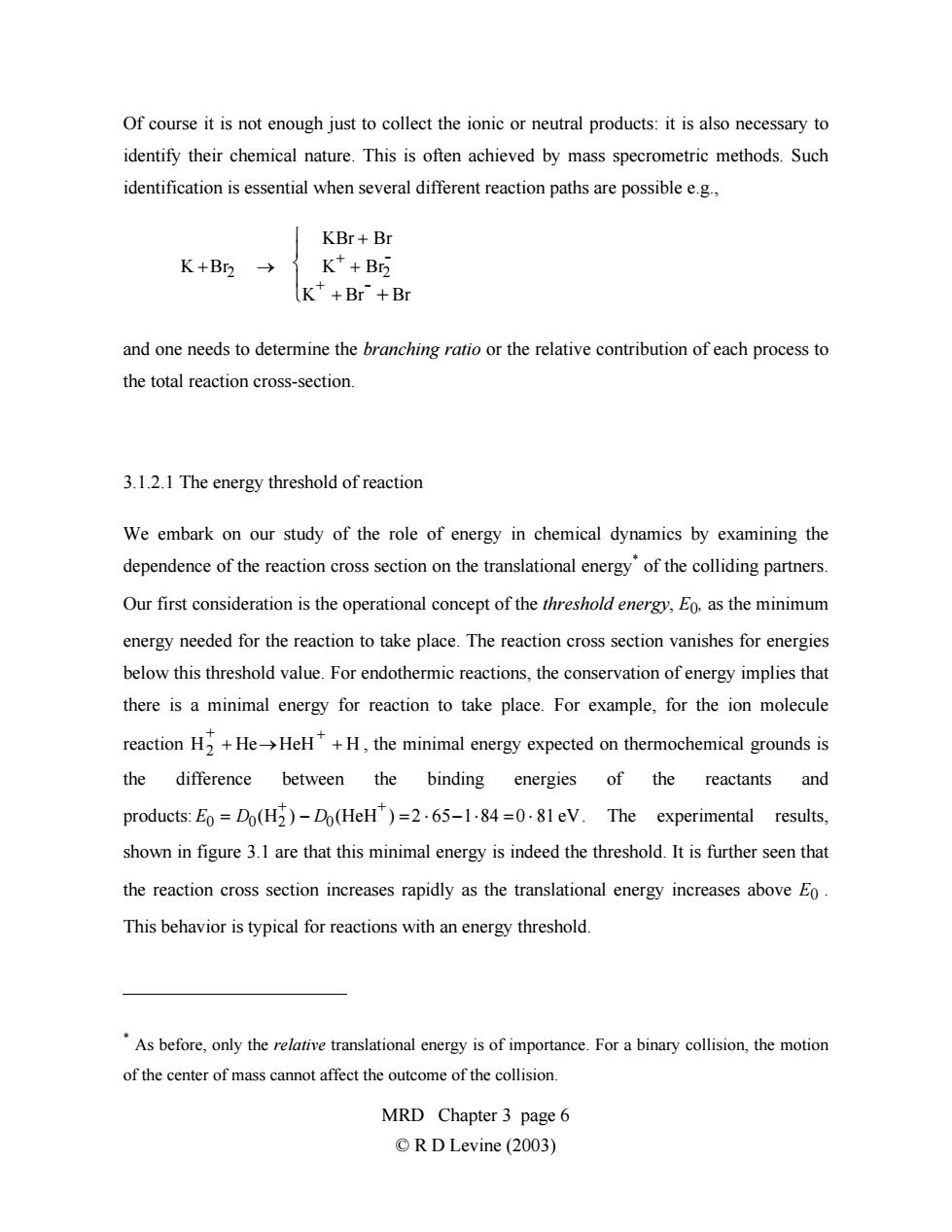正在加载图片...

Of course it is not enough just to collect the ionic or neutral products:it is also necessary to identify their chemical nature.This is often achieved by mass specrometric methods.Such identification is essential when several different reaction paths are possible e.g., KBr+Br K+Br2 K++B2 K*+Br+Br and one needs to determine the branching ratio or the relative contribution of each process to the total reaction cross-section. 3.1.2.1 The energy threshold of reaction We embark on our study of the role of energy in chemical dynamics by examining the dependence of the reaction cross section on the translational energy'of the colliding partners. Our first consideration is the operational concept of the threshold energy,E0,as the minimum energy needed for the reaction to take place.The reaction cross section vanishes for energies below this threshold value.For endothermic reactions,the conservation of energy implies that there is a minimal energy for reaction to take place.For example,for the ion molecule reaction H2+He>HeH+H,the minimal energy expected on thermochemical grounds is the difference between the binding energies of the reactants and products:Eo=Do(H2)-Do(HeH")=2.65-1-84=0.81 eV.The experimental results, shown in figure 3.1 are that this minimal energy is indeed the threshold.It is further seen that the reaction cross section increases rapidly as the translational energy increases above Eo. This behavior is typical for reactions with an energy threshold. As before,only the relative translational energy is of importance.For a binary collision,the motion of the center of mass cannot affect the outcome of the collision. MRD Chapter 3 page 6 ©R D Levine(2003)Of course it is not enough just to collect the ionic or neutral products: it is also necessary to identify their chemical nature. This is often achieved by mass specrometric methods. Such identification is essential when several different reaction paths are possible e.g., K +Br2 → KBr + Br K+ + Br2 - K+ + Br- + Br and one needs to determine the branching ratio or the relative contribution of each process to the total reaction cross-section. 3.1.2.1 The energy threshold of reaction We embark on our study of the role of energy in chemical dynamics by examining the dependence of the reaction cross section on the translational energy* of the colliding partners. Our first consideration is the operational concept of the threshold energy, E0, as the minimum energy needed for the reaction to take place. The reaction cross section vanishes for energies below this threshold value. For endothermic reactions, the conservation of energy implies that there is a minimal energy for reaction to take place. For example, for the ion molecule reaction , the minimal energy expected on thermochemical grounds is the difference between the binding energies of the reactants and products: . The experimental results, shown in figure 3.1 are that this minimal energy is indeed the threshold. It is further seen that the reaction cross section increases rapidly as the translational energy increases above E H2 + + He→HeH+ + H E0 = D0(H2 +) − D0(HeH+) =2 ⋅ 65−1⋅84 =0 ⋅ 81 eV 0 . This behavior is typical for reactions with an energy threshold. * As before, only the relative translational energy is of importance. For a binary collision, the motion of the center of mass cannot affect the outcome of the collision. MRD Chapter 3 page 6 © R D Levine (2003)